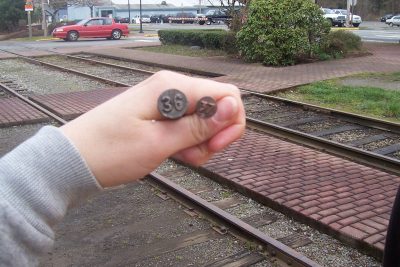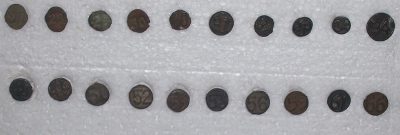Railroad date nails are small nails with numbers stamped on the head. They are often found in railroad collections and in railroad art. But what were date nails used for? Dan C. continues his talk about date nails and their origin in this article from the April 2006 Sounder. Part one can be found here.
The use of date nails became common in the early 1900’s due to the railroads perception that the treated ties were not much longer lived than the untreated ones. While in some cases, an untreated tie was no longer serviceable after two years, the early treatment methods were proven through the use of date nails affixed at the treatment plant to last nine or ten years. Successful, cost-effective treatment using creosote would not come into common use in the US until about 1922-3. This was due in part to the interruption of the supply (from Europe) of high quality creosote during WWI. The collapse of the economy in 1929 led to a temporary reversion to cheaper Zinc Chloride treatment, or the use of untreated ties. By then creosote treated ties had proven their value, and as soon as the railroads felt they could afford them again, they came into common use. Despite the increased weight and speed of trains and locomotives, the creosote treated tie was lasting about 35 years in 1969. Considering that, it is surprising that it took over fifty years for the railroads to fully adopt creosote treated ties. It has been reported that the Spokane International did not use treated ties until after 1949.

Photo originally published in the April 2006 Sounder.
In the Northwest, the Spokane, Portland & Seattle Railway (SP&S) only used date nails from 1926-34. The Union Pacific (UP) used date nails extensively until about 1936, and again in 1964. My 1939 “Railway Engineering and Maintenance Cyclopedia” shows a standard specification adopted in 1936 by the AREA for machined ties that included branding of the tie with a variety of information. This is the current practice for all treatment plants of which I am aware. Date nails continued to be popular on several railroads up until the mid to late 1960’s. My 1969 Great Northern nail is the last date nail produced for them.
Date nails are commonly made of steel, but there are examples in aluminum, brass, copper and malleable iron. I have some copper nails that a friend recovered from some Milwaukee ties he was using for landscaping his home in North Bend. Most of the nails are more or less round, both in the shank and the head, but again, variations exist. I have some Canadian National nails that have square, twisted shanks, and some that have oval shanks.

Photo originally published in the April 2006 Sounder.
Nails were commonly used for other purposes, among which are to show the age, length or depth of drive for piles and poles. Also, both the UP and a company called Southern Wood Piedmont used nails to mark switch ties as to their length. The standard tie on the UP was an eight footer, so the switch nails started at 8’6” and went up to 15’. You may spot one of these nails at the museum, as we acquired quite a bit of track material from the UP in the late 80’s when Union Station (Seattle) was taken out of service.
For more information, the reader is referred to “Date Nails and Railroad Tie Preservation” by Jeff Oates. This was the source of much of the information contained in this article.

